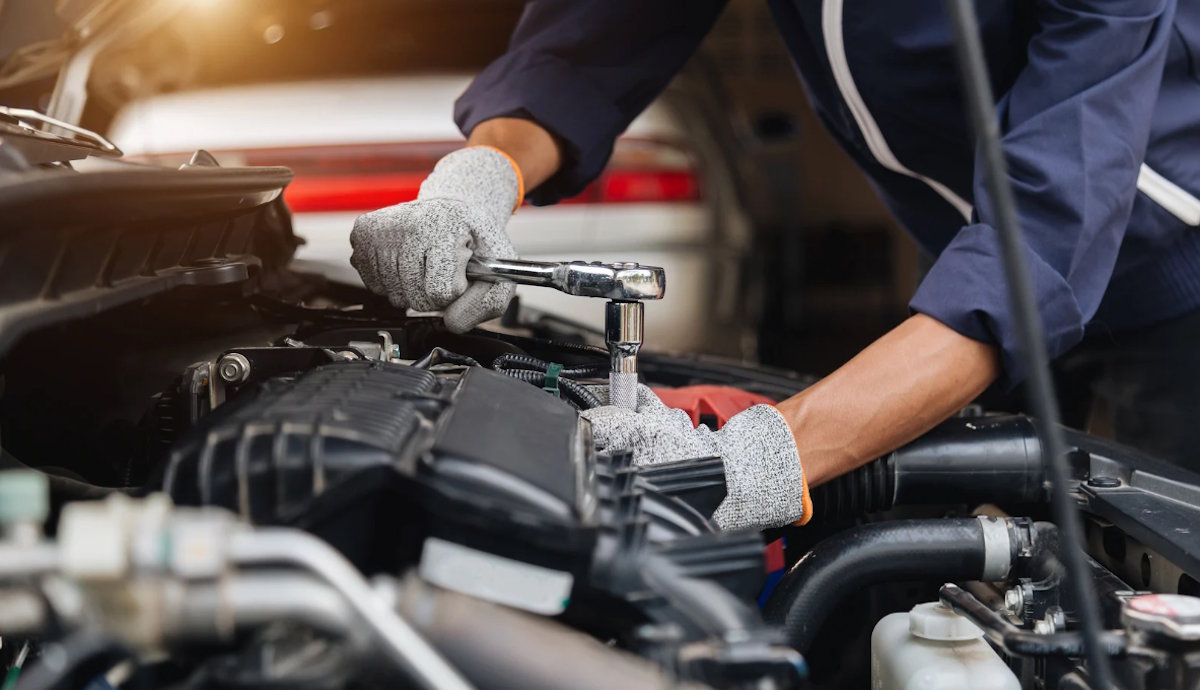In the sprawling, vibrant automotive market of the UAE, choices abound. You can find a part for any car, from any year, at almost any price. For a car owner staring down a repair bill, the temptation to find a “deal” is overwhelming. You search online or visit a dusty spare-parts shop, and you are presented with a box. It looks exactly like the manufacturer’s box. It has the blue-and-white logo. It has the holographic sticker. It has a part number that matches perfectly. And, most enticingly, it costs half the price of the part the dealership or the specialist garage quoted you. You feel a rush of victory. You believe you have outsmarted the system and found a loophole that saves you money without compromising quality.
This moment of victory is, in reality, the moment you have fallen into the most sophisticated and dangerous trap in the modern automotive world. You have likely just purchased a counterfeit part. This is not a generic or “aftermarket” part, which is a legitimate alternative. This is a “fake,” a criminal forgery designed to look identical to the original on the outside while being structurally hollow, chemically unstable, and mechanically lethal on the inside. The global trade in fake car parts is a multi-billion-dollar industry that thrives on your desire for a bargain, and it places you, your family, and your vehicle in immediate, uncalculated danger every time you turn the key.
The Diagnostic Discovery: Finding the Time Bomb
The tragedy of the counterfeit part is that the owner rarely knows they have been duped until the moment of catastrophic failure. It is often only when a vehicle arrives at a specialist garage for routine General Maintenance & Repairs that the deception is uncovered. Our master technicians will often remove a failed component, such as a collapsed oil filter or a disintegrated brake pad, and recognize the subtle, tell-tale signs of a forgery that a general mechanic would miss. The owner is often shocked, having paid “full price” to a previous shop for what they were told was a genuine part, only to discover they have been driving with a ticking time bomb that has now caused collateral damage to the engine or suspension.
The “Brake Pad” Betrayal: Compressed Grass and Glue
The most terrifying category of counterfeit parts lies in the braking system, simply because the consequences of failure are so immediate and life-threatening. A genuine brake pad is a marvel of chemical engineering, a precise mixture of copper, ceramics, and high-friction compounds designed to withstand temperatures of over 500 degrees Celsius without fading or crumbling. It is bonded to the steel backing plate with industrial-grade, heat-resistant adhesives that ensure the friction material never separates, even under the most violent emergency stop.
A counterfeit brake pad is a visual clone, but chemically, it is an imposter. Investigations into seized fake parts have revealed friction materials made of compressed grass, sawdust, dried paint, and cheap, low-temp glues. In the high-heat environment of a UAE summer, the first time you perform a hard brake from highway speeds, the heat generated simply melts the glue. The friction material separates from the backing plate and disintegrates, leaving you pressing the brake pedal against a bare metal plate. You do not just lose “stopping power”; you lose the brakes entirely. The “money saved” on the pad is instantly negated by the catastrophic accident that follows, proving that the only safe braking system is one verified by a trusted supply chain.
The “Filter” Fallacy: Starving the Engine to Death
While brake failure is a safety threat, filter failure is a financial one, capable of destroying a perfectly good engine in a matter of weeks. An oil filter seems like a simple metal can, making it an easy target for counterfeiters. A genuine filter contains a carefully pleated synthetic or cellulose media that traps microscopic dirt while allowing oil to flow freely at high pressure. It also contains a robust internal valve system to prevent oil from draining back when the engine is off, ensuring start-up lubrication.
The counterfeit filter is a hollow shell. Inside the convincing metal can, the “filter media” is often nothing more than waste paper or loose cotton that lacks the structural integrity to withstand hot, pressurized oil. Under the intense pressure of a running engine, this weak paper collapses and tears, sending chunks of debris directly into the engine’s oil galleries. Even worse, the relief valves are often poorly made or missing entirely, meaning the filter either blocks oil flow completely or allows dirty, unfiltered oil to bypass the system permanently. The driver sees a clean-looking oil filter on the outside, while the inside of the engine is being scoured by grit and starved of lubrication, leading to a seized engine and a repair bill that exceeds the value of the car.

The “Spark Plug” Sabotage: Melting Metal in the Chamber
The modern engine is a precision instrument, and the spark plug is its heartbeat. Genuine spark plugs, especially those using iridium or platinum, are manufactured to microscopic tolerances to ensure they can fire millions of times without eroding. The ceramic insulator is designed to withstand thousands of volts, and the metal tip is welded with laser precision to ensure it never falls off.
Counterfeiters flood the market with fake “iridium” plugs that are actually made of cheap, soft nickel or standard copper. While they may work for a short time, they cannot handle the heat of a modern combustion chamber. The most common failure mode for these fakes is for the central electrode or the ceramic insulator to crack and fall off. Gravity takes over, and this small piece of super-hard metal or ceramic falls directly into the engine cylinder. It bounces around like a bullet, scoring the cylinder walls, smashing the piston, and bending the valves. A set of fake plugs might save you a few hundred dirhams, but the resulting engine rebuild will cost tens of thousands, all because the material quality was invisible to the naked eye.
The “Rubber” Ruse: Belts and Hoses That Snap
In the intense heat of the Middle East, rubber components are under constant assault. Genuine belts, hoses, and bushings are made from EPDM (Ethylene Propylene Diene Monomer) or other advanced synthetic rubbers that are chemically formulated to resist heat, ozone, and stretching. They are designed to last for years in a desert environment without drying out or cracking.
Counterfeit rubber parts are typically made from recycled, low-grade rubber that has been polished to look new. It lacks the chemical stabilizers required to survive 50-degree heat. A fake timing belt or serpentine belt may look robust when installed, but it will dry-rot and become brittle in a fraction of the time of a genuine part. When a timing belt snaps, the engine’s internal synchronization is lost, leading to pistons colliding with valves and immediate, catastrophic engine death. The visual difference between a high-quality belt and a cheap fake is almost impossible to detect until the moment it snaps, making the source of the part the only reliable indicator of quality.
The Supply Chain Solution: Why “Who” Matters More Than “What”
The existence of these undetectable fakes fundamentally changes how a car owner must approach maintenance. You can no longer rely on your own eyes to judge the quality of a part in a box. The packaging is too perfect, the printing is too sharp, and the part itself looks too real. The only way to guarantee that a part is genuine is to verify its journey, not its appearance. This is the concept of the “Chain of Custody.”
A professional, specialist garage does not buy parts from random online marketplaces or unverified street vendors. We establish direct, contractual relationships with authorized distributors and the manufacturers themselves. We pay a premium for this access because it comes with a guarantee of authenticity. When we install a part, we are backing it with a warranty that includes labor, something a counterfeit seller will never do. The “extra” cost you pay at a reputable garage is not just for the part; it is for the rigorous vetting of the supply chain that ensures the brake pad will stop the car, the filter will clean the oil, and the belt will hold the engine together.
Conclusion: The True Cost of the “Cheaper” Option
In the end, the allure of the counterfeit part is a psychological trick. It plays on the desire to be a savvy shopper, to find the hidden deal that everyone else missed. But in the automotive world, there are no miracles. Manufacturing high-quality, heat-resistant, precision-engineered components costs money. If a part is being sold for significantly less than the market rate, corners have been cut—not in the marketing or the packaging, but in the materials that keep you safe.
Choosing to maintain your vehicle with a trusted partner who refuses to compromise on part quality is the only defense against this invisible flood of fakes. It shifts the focus from the price on the invoice to the value of safety and reliability. When you are driving at highway speeds with your family in the car, the peace of mind that comes from knowing your brakes, tires, and engine components are genuine is a value that far exceeds the few dirhams saved on a questionable box from an unknown source. We invite you to trust not just our hands, but our sources, ensuring that your vehicle remains the safe, reliable machine it was built to be.

